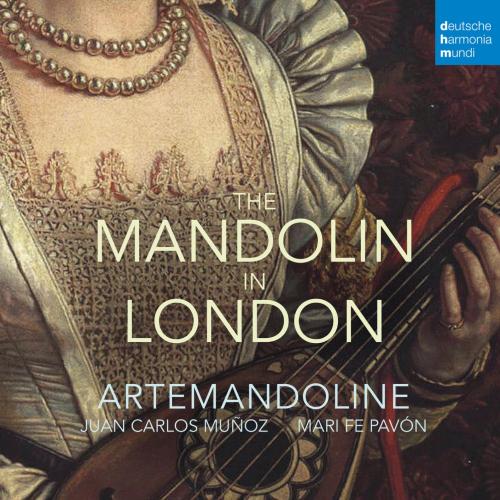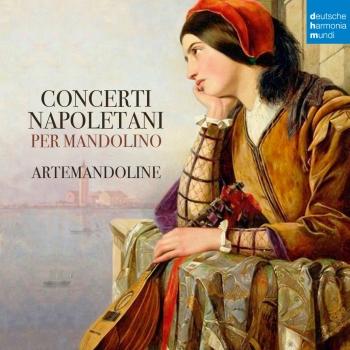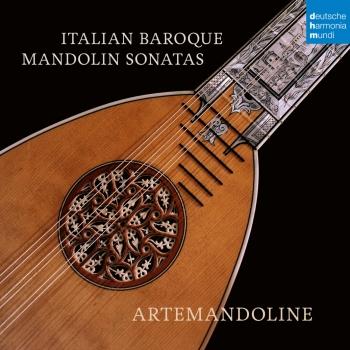
The Mandolin in London ArteMandoline
Album info
Album-Release:
2024
HRA-Release:
10.05.2024
Label: deutsche harmonia mundi
Genre: Classical
Artist: ArteMandoline
Composer: Giovanni Francesco Weber (1724-1751), Robert Valentine (1680-1735), Giacomo Merchi (1730-1789), Girolamo Nonnini (1730-1800), Carlo Arrigoni (1697-1744), James Oswald (1711-1769), Joseph Vernon (1738-1782), Girolamo Stabilini (1762-1815)
Album including Album cover Booklet (PDF)
I`m sorry!
Dear HIGHRESAUDIO Visitor,
due to territorial constraints and also different releases dates in each country you currently can`t purchase this album. We are updating our release dates twice a week. So, please feel free to check from time-to-time, if the album is available for your country.
We suggest, that you bookmark the album and use our Short List function.
Thank you for your understanding and patience.
Yours sincerely, HIGHRESAUDIO
- Giovanni Francesco Weber (1724 - 1751): Mandolin Sonata No. 4:
- 1 Weber: Mandolin Sonata No. 4: I. Andante 03:16
- 2 Weber: Mandolin Sonata No. 4: II. Larghetto 01:40
- 3 Weber: Mandolin Sonata No. 4: III. Gavotta 01:44
- Robert Valentine (1671 - 1747): Mandolin Sonata No. 1:
- 4 Valentine: Mandolin Sonata No. 1: I. Adagio 01:40
- 5 Valentine: Mandolin Sonata No. 1: II. Allegro 01:23
- 6 Valentine: Mandolin Sonata No. 1: III. Andante 02:22
- 7 Valentine: Mandolin Sonata No. 1: IV. Allegro 00:59
- Giacomo Merchi (1726 - 1789): Mandolin Trio No. 1:
- 8 Merchi: Mandolin Trio No. 1: I. Andantino 03:58
- 9 Merchi: Mandolin Trio No. 1: II. Allegro assai 03:41
- 10 Merchi: Mandolin Trio No. 1: III. Minuetto 02:41
- Girolamo Nonnini (1726 - 1789): Six Italian Canzonettas:
- 11 Nonnini: Six Italian Canzonettas: III. Allegro comodo 04:06
- Carlo Arrigoni (1697 - 1744): Sonata for Mandolin and Basso continuo:
- 12 Arrigoni: Sonata for Mandolin and Basso continuo: I. Grave 01:09
- 13 Arrigoni: Sonata for Mandolin and Basso continuo: II. Allegro 01:10
- 14 Arrigoni: Sonata for Mandolin and Basso continuo: III. Grave 01:55
- 15 Arrigoni: Sonata for Mandolin and Basso continuo: IV. (Gigue) 01:56
- Girolamo Nonnini (1726 - 1789): Six Italian Canzonettas:
- 16 Nonnini: Six Italian Canzonettas: IV. Allegro comodo 03:33
- James Oswald (1711 - 1769): Divertimento No. 6:
- 17 Oswald: Divertimento No. 6: I. Aria Andante 01:11
- 18 Oswald: Divertimento No. 6: II. Aria Moderato 01:30
- 19 Oswald: Divertimento No. 6: III. Giga 00:50
- Bernard Flemming (1711 - 1769): The Musical Companion:
- 20 Flemming: The Musical Companion: Air 02:53
- Joseph Vernon (1738 - 1782): What is that to you:
- 21 Vernon: Air: What is that to you 02:33
- Girolamo Stabilini (1762 - 1815): Jig:
- 22 Stabilini: Jig 01:32
- James Oswald: Divertimento No. 16:
- 23 Oswald: Divertimento No. 16: I. Aria Graciousament 01:41
- 24 Oswald: Divertimento No. 16: II. Vivace 00:27
- 25 Oswald: Divertimento No. 16: III. Con spirito Giga Andante 01:01
- Giovanni Francesco Weber: Mandolin Sonata No. 12:
- 26 Weber: Mandolin Sonata No. 12: I. Andante 02:30
- 27 Weber: Mandolin Sonata No. 12: II. Larghetto 03:38
- 28 Weber: Mandolin Sonata No. 12: III. Gavotta 02:05
- Francesco Bartolomeo Conti (1681 - 1732): Mandolin Sonata:
- 29 Conti: Mandolin Sonata: I. Arpeggio 01:13
- 30 Conti: Mandolin Sonata: II. Allemanda 02:04
- 31 Conti: Mandolin Sonata: III. Sarabanda 02:21
- 32 Conti: Mandolin Sonata: IV. Minuetto 01:13
Info for The Mandolin in London
The mandolin achieved great popularity in 18th century Britain. Due to the intensive musical exchange in Europe and in particular the influence of Italian musicians and composers who travelled, performed and taught in Great Britain, the mandolin became a popular instrument that was played in opera houses, concert halls, variety theatres, the royal family and private salons.
The ensemble Artemandoline, under the direction of Juan Carlos Muñoz & Mari Fe Pavon, has specialised in researching the history and repertoire of the baroque mandolin and has selected some of the best works for mandolin from this period for their new album. The album contains rare musical treasures, including instrumental works for mandolin solo and ensemble as well as several pieces for baroque mandolin and soprano, sung by the Italian singer Marina Bartoli. Artemandoline has recorded dreamy but also lively pieces, sonatas by composers of the time such as Giovanni Francesco Weber (1724-1751), Francesco Bartolomeo Conti (1681-1732) and Carlo Arrigoni (1697-1744) as well as lively jigs by Girolamo Stabilini (1762-1815) and enchanting canzonettas by Girolamo Nonnini (ca. 1730-c-1790). These composers, who were famous for their virtuosity on the mandolin, had a decisive influence on the musical heritage of the instrument and can now be heard in world premiere recordings.’
Maria Bartoli Compostella, soprano
Mari Fe Pavon, baroque mandolin
Artemandoline
Juan Carlos Munoz, baroque mandolin, direction
Artemandoline
With their ensemble Artemandoline, formed in 2001, Juan Carlos Muñoz and Mari Fe Pavón chose to go back to the original documents in order to the establish the true pedigree of this incomparable family of instruments. They have made a major contribution to launching a movement to encourage musical freshness and rigour. A better understanding of the compositions, closer study of the early treatises, the playing styles, the musical environment of the glorious era of the mandolin, leads to better appreciation of Baroque music, which itself became over time a mode of thought and action.
Searching for early mandolins, working on the manuscripts, hunting down early treatises, exploring the iconography: these are the means by which, for more than ten years now, the musicians of Artemandoline have sought to do fuller justice to the works of Scarlatti, Vivaldi, Weiss, and their contemporaries. The success of this approach based on a return to the sources, which constitutes the most important development in the history of the interpretation of ‘serious’ music in the course of the twentieth century, has been made possible by the cooperation of many protagonists – musicians, but also concert organisers, recording producers, publishers, musicologists, and instrument makers.
To ensure that music composed in the past does not sound like mere ‘early music’ in the present, the performers must manage to be sufficiently free, spontaneous, anticipative and astonished in their intimate act of creation and the newness it engenders. Juan Carlos Muñoz and Mari Fe Pavón spend their lives searching out and reviving forgotten masterpieces of the mandolin repertory. They are not content with simply presenting their finds like ‘musical archaeologists’, but endeavour to transmit them to the wider public by means of the essential act of communication between interpreters, composers, and listeners.
Very quickly awarded prizes by the critics and enthusiastically acclaimed by the public, Artemandoline’s performances always create new impulsions in the development of both the perception and the interpretation of the works of the seventeenth and eighteenth centuries. Its musicians dedicate their time and their talents to the revival of the mandolin on the musical scene, participating in the current expansion of interest in it all over the world through their conservatory teaching and masterclasses, their concerts, and their publications. Artemandoline is one of the pioneers in this domain, in which it has forged an international reputation.
In a few short years, the ensemble has found its style, proved its instrumental quality, and thereby constituted a veritable identity. Soon after its formation, it took its place among the foremost ensembles in the realm of historical performance practice on plucked strings. Audiences and critics alike were immediately filled with enthusiasm for its lively musical style.
The musicians who make up the ensemble play on period instruments: Baroque mandolins, Renaissance and Baroque guitar, Baroque mandola and mandolone, Renaissance lute, treble lutes, mandolins from Brescia and Cremona.
They are regularly invited to appear at early music festivals in France and abroad, including the Festival de Musique Ancienne du Marais, Festival du Périgord Vert, the « Tage Alter Musik Regensburg » in Germany ; « Early Music Day Alden-Biesen (Belgique) », Musique en Catalogne romane, Festival de l’Épine in France; Monza e Brianza, Gaudete Early Festival (Piedmont), and Castello Reale di Sarre (Aosta), all in Italy; Narol and Wroclaw in Poland; the Baroque Days at the Philharmonie in Luxembourg;; the Bach Chamber Days in Riga (Latvia); Festival Musique d’Ensemble à Pommiers, Oissery, Sedan, and other engagements in Spain, Japan, Switzerland, and Algeria.
The ensemble Artemandoline is in residence at the Romanesque church of Mont St Martin (Longwy, Meurthe-et-Moselle, France).
Booklet for The Mandolin in London

















